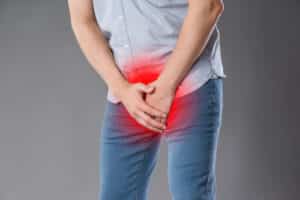Testicular torsion is the twisting of the spermatic cord that can lead to permanent pain and infertility. The condition is most common in men under the age of 25, specifically among those between the ages of 12 and 18, however is can occur at any age.
Testicular torsion occurs when the blood flow to the testicle, via the spermatic cord, gets twisted and blocked. When the testicle has a lack of or no blood supply, it fails to work and eventually the organ dies.
The good news is, testicular torsion, though serious, is a rather rare condition that, when treated properly, can be resolved and not lead to any lasting pain or damage.
Causes and Risk Factors for Testicular Torsion
As previously mentioned, testicular torsion is a rare condition, affecting only about one in 4,000 males. For the most part, research has found that in a majority of cases, onset is due to a congenital abnormality, however this condition is also spontaneous in some cases as well. In some cases, the onset of the condition may be associated to previous pelvic surgery which lead to damaged blood vessels, severe injury to the groin leading to a tear in the spermatic cord, or severe infection within the testicle.
One of the most common development abnormalities is referred to as a bell clapper deformity, in which men are born with no tissue holding the testes to the scrotum, allowing the tests to “swing” inside the scrotum.
Additionally, there are some factors that are considered to increase the chances of testicular torsion onset. These include; cold climates, as a sudden temperature change from warmth when the scrotum expands and then constricts when it starts to get colder; age, as this condition is more likely to occur in males between 12 and 25 years old; and family history, since men with a positive family history of testicular torsion are more at risk for developing this condition due to a genetic disorder.
Symptoms of Testicular Torsion

In some cases, testicular torsion can occur before or shortly after birth, in which case, it is typically not possible to save the testicle, and the child will need surgery after birth for proper diagnosis and to correct the condition to prevent it from occurring in the other testicle or to prevent future reproductive problems.
Treatment
When it comes to testicular torsion, the condition must be dealt with immediately to prevent permanent damage or loss of the entire testicle, and surgery is usually required to save the testicle and the spermatic cord.
The surgical treatment typically consists of untwisting the spermatic cord and reconnecting the blood vessels that supply blood to it and the testicle. In severe cases when damage has already occurred, the treatment option will be to remove the damaged piece of the testicle, to save the rest of it by using a secondary vasectomy.
A doctor will perform the surgery immediately, within six to eight hours of prognosis, to limit damage and ensure that the saved testicle can continue to function properly afterward. The surgery and its recovery time depend on how long diagnosis and treatment of the condition takes.
The severity of the impact often depends on the age of the man and whether or not he was able to receive timely medical attention. If this condition is not treated, it can irreversibly damage or destroy the entire testicle, resulting in male infertility.
How Testicular Torsion Affects Male Fertility
The reason why this condition can affect male fertility is, in short, that the testicle is needed to produce sperm. When one of these organs is damaged, it affects the production of quality sperm and their motility.
The onset of testicular torsion can decrease the survival of sperm. When this happens, men will have less sperm in their semen to fertilize an egg, ultimately leading to male fertility problems.
The severity of the impact on fertility differs from case to case. Like treatment success, it can vary depending on how old the man was when he was diagnosed with this condition and whether or not he was able to receive timely medical attention.
In short, if a diagnosis of testicular torsion has been made, treatment is needed immediately, before long-term damage is done or fertility is affected.
In cases where infertility is experienced after treatment, it is important to contact a medical professional to express what might have caused it. This knowledge may lead to fertility doctor being able to treat the man’s condition for him to regain his fertility.




